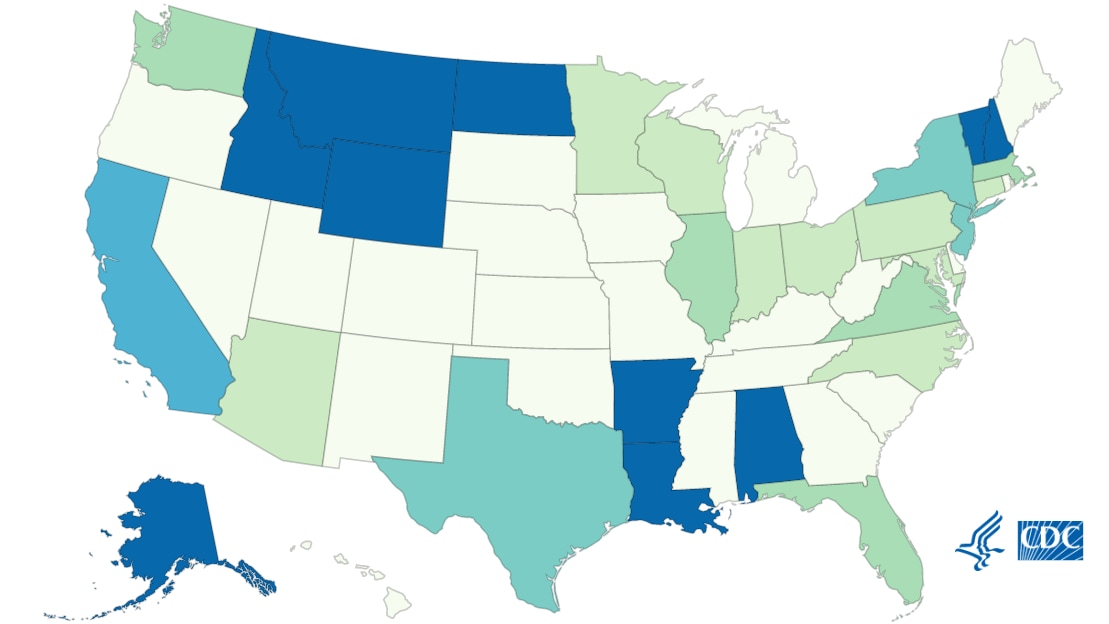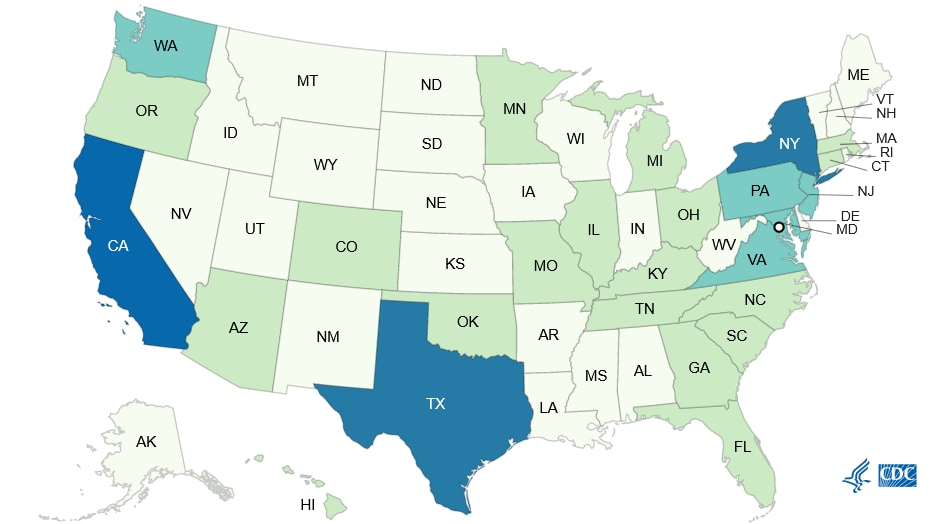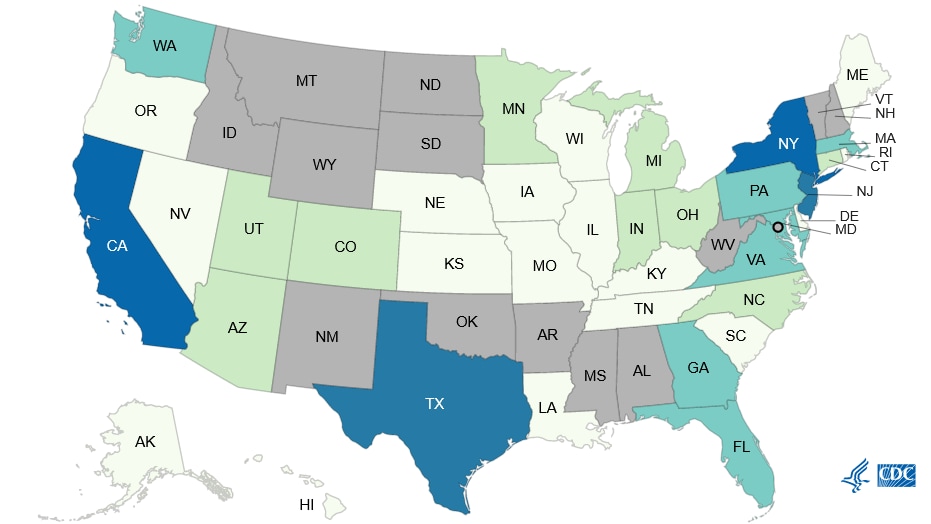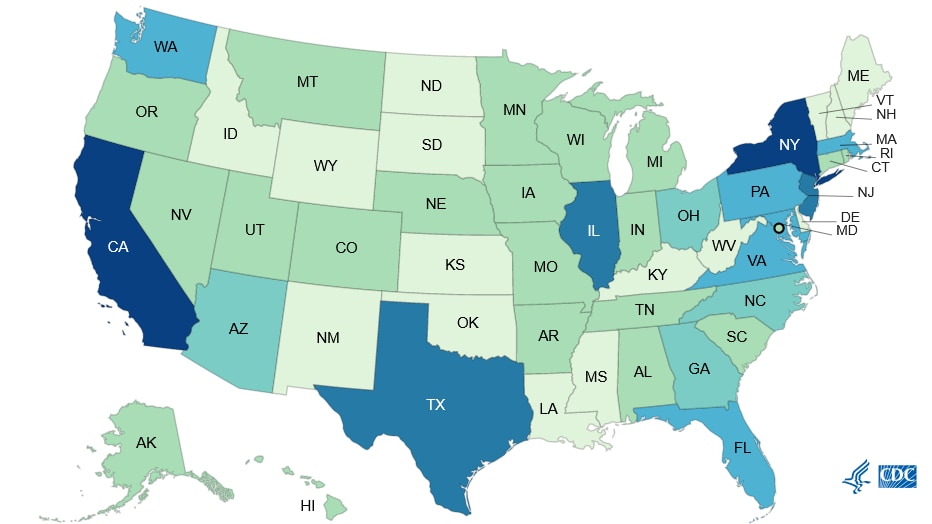At a glance
- State and local health departments report cases of typhoid fever and paratyphoid fever to CDC.
- CDC uses information from the reports to determine incidence and trends, make recommendations, and guide prevention efforts.

What data we collect
CDC collects surveillance data for typhoid fever and paratyphoid fever, both of which are nationally notifiable conditions.A
State and local health officials use a standard form to collect detailed information on laboratory-confirmed cases. Information collected about the patient includes:
- Demographic information
- Clinical information
- Typhoid vaccination status
- Travel history
This information is reported to the National Typhoid and Paratyphoid Fever Surveillance System (NTPFS).
Key findings
Data from NTPFS and other surveillance systems inform our understanding of typhoid fever and paratyphoid fever in the United States.
Incidence
In the United States each year, about
- 350 people are diagnosed with typhoid fever
- 90 people are diagnosed with paratyphoid fever
These cases do not include people who do not seek medical care, who are not tested for either disease, or whose disease is not reported.
The true number of cases is likely much higher. CDC estimates that 5,700 of cases of typhoid fever occur in the United States each year. CDC does not have estimates for Salmonella Paratyphi.
Trends
Almost all cases occur among international travelers.
- These diseases are common in many areas of the world, affecting an estimated 13 million people yearly.
- Most travelers with these diseases in the United States have returned from South Asia, primarily Bangladesh, India, and Pakistan.
- Some travelers have reported visiting other countries in Asia, Africa, and Latin America.
The number of cases varies annually and is affected by changes in international travel.
- CDC has received reports of as few as 150 cases to as many as 450 cases of typhoid fever per year during the past few years.
- During 2020–2021, CDC received fewer reports of cases.
- Decreases in international travel and other factors connected to the COVID-19 pandemic likely influenced the transmission, detection, and reporting of enteric illnesses.
- Decreases in international travel and other factors connected to the COVID-19 pandemic likely influenced the transmission, detection, and reporting of enteric illnesses.
Antibiotic-resistant typhoid fever is on the rise
- Treatment should be guided by travel history and resistance testing.
- To prevent the spread of resistance, take all antibiotics as prescribed.
- More information about the management of drug-resistant typhoid fever is available.
Annual summaries of national data
Annual summaries for 2015 and 2016 are available in CDC Archive. Data for the maps of the 2015 summary are included on a separate page.
Other surveillance systems
Several other systems at CDC conduct surveillance for infection with Salmonella serotypes Typhi, Paratyphi A, Paratyphi BB, and Paratyphi C.
- National Notifiable Diseases System
- Collects and compiles reports of laboratory confirmed and probable cases of typhoid fever and paratyphoid fever.
- Collects and compiles reports of laboratory confirmed and probable cases of typhoid fever and paratyphoid fever.
- Laboratory-based Enteric Disease Surveillance System
- Conducts national surveillance for laboratory-confirmed Salmonella infections.
- Conducts national surveillance for laboratory-confirmed Salmonella infections.
- National Antimicrobial Resistance Monitoring System (NARMS)
- Monitors antimicrobial resistance among Salmonella.
- Since 1999, NARMS has requested that all serotype Typhi, Paratyphi A, Paratyphi B, and Paratyphi C isolates in the United States be sent to CDC for antimicrobial susceptibility testing.
- Monitors antimicrobial resistance among Salmonella.
- National Outbreak Reporting System
- Collects data on domestic outbreaks of typhoid fever and paratyphoid fever from local, state, and territorial health departments.
- Collects data on domestic outbreaks of typhoid fever and paratyphoid fever from local, state, and territorial health departments.
- Foodborne Diseases Active Surveillance Network
- Conducts active, population-based surveillance in 10 states for laboratory-confirmed Salmonella infections.
- Conducts active, population-based surveillance in 10 states for laboratory-confirmed Salmonella infections.
- In 2019, the case definitions for Typhoid Fever and Paratyphoid Fever changed. They are now reported as Salmonella Typhi or Paratyphi infections.
- Two distinct pathotypes of Salmonella serotype Paratyphi B are recognized; one pathotype is associated with paratyphoid fever and the other is associated with uncomplicated gastroenteritis. The two pathotypes are known to have distinct virulence characteristics, but are currently differentiated based on the ability to ferment tartrate. The paratyphoidal pathotype is unable to ferment tartrate and is designated serotype Paratyphi B; the gastrointestinal pathotype ferments tartrate and is designated serotype Paratyphi B var. L(+) tartrate+.




